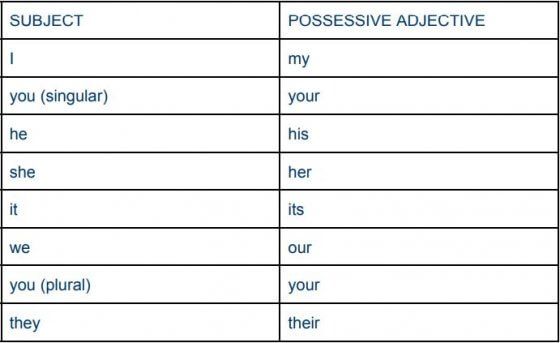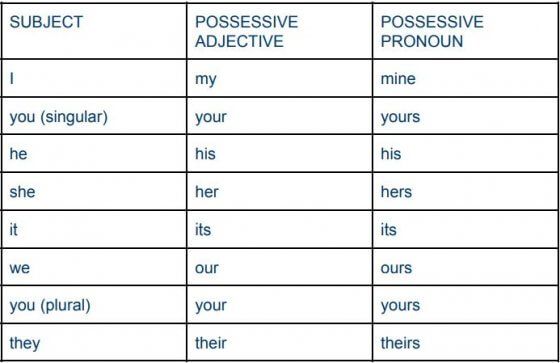Possessive Adjectives and Pronouns
There are many occasions in which we need to refer to something that belongs to a person. For example, in the simple question, “What’s your name?” The word ‘your’ lets us indicate whose name we are talking about. There are two ways to describe possession in English – using adjectives and using pronouns. Here are some details to help you understand how to use each and what the difference is.
Possessive Adjectives
We use possessive adjectives to express who owns (or ‘possesses’) something. A possessive adjective is used in front of a noun (a thing). For example:
My computer.
Your pen.
Our car.
The possessive adjectives in English are as follows:

Here are some examples:
What’s your address?
My car is in front of the school.
This is Jack and this is his wife, Sue.
Put your coats on the back of your seats.
Our new Maths teacher is very nice.
What a beautiful bird! Its feathers are bright blue!
My sister is always tired. Her job is difficult.
His and Her
Remember that in English, nouns don’t have a gender and are therefore neither masculine nor feminine. So when we use ‘his’ we mean that the object is ‘of a man’, and when we use ‘her’ we mean that the object is ‘of a woman’. For example:


Possessive Pronouns
As with possessive adjectives, we use possessive pronouns to indicate who owns something, but with pronouns we don’t use a noun. We use possessive pronouns when it is clear which object we are referring to. For example:
Whose pen is this? It’s mine. (meaning ‘my pen’)
Here are all the possessive pronouns:

As you can see, the pronouns ‘his’ and ‘its’ are the same as the adjectives, while the others change by adding an -s, with the exception of ‘mine’. Here are some examples:
That’s Anna’s homework and this is yours.
Your hotel is near the city center while ours is near the airport.
I love your sofa. Mine isn’t as comfortable is yours.
We don’t need help with our project but the boys need help with theirs.
Is this Carol’s bicycle? – No, that red one over there is hers.
Whose game is this? – Sam was playing earlier so it must be his.
We also use possessive pronouns after a noun + ‘of’. For example:
I’m a friend of his.
You’re a student of mine.
She’s a colleague of ours.
Here is a chart with both the possessive adjectives and pronouns for you to use as a reference:

So, now you’ve seen the difference between possessive adjectives and pronouns, it’s time to practice! Try making some of your own examples, especially for the third person singular (‘his’ and ‘her/hers’), by writing some basic information about you, family members and friends. Using these possessive words correctly will really make a big difference to your English fluency!
There are nine main forms of punctuation that we use frequently when we write. What are they, and how are they used in English? Let’s see!
When we give a time reference there are various words we use such as at, on, in, and also for and since. Read on to find out when to use each one of them.